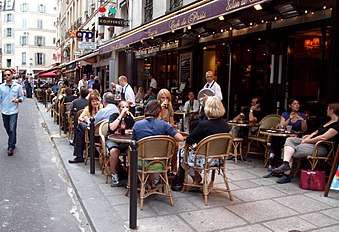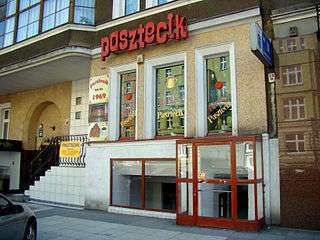Culinary tourism

Culinary tourism or food tourism is the exploration of food as the purpose of tourism.[1] It is now considered a vital component of the tourism experience.[2] Dining out is common among tourists and "food is believed to rank alongside climate, accommodation, and scenery" in importance to tourists.[2]
Overview
Culinary or food tourism is the pursuit of unique and memorable eating and drinking experiences, both near and far.[3] Culinary tourism differs from agritourism in that culinary tourism is considered a subset of cultural tourism (cuisine is a manifestation of culture) whereas agritourism is considered a subset of rural tourism,[4] but culinary tourism and agritourism are inextricably linked, as the seeds of cuisine can be found in agriculture. Culinary/food tourism is not limited to gourmet food.[5] Food tourism can be considered a subcategory of experiential travel.
While many cities, regions or countries are known for their food, culinary tourism is not limited by food culture. Every tourist eats about three times a day, making food one of the fundamental economic drivers of tourism. Countries like Ireland, Peru and Canada are making significant investment in culinary tourism development and are seeing results with visitor spending and overnight stays rising as a result of food tourism promotion and product development.[6]
The World Food Travel Association offers the following clarification and definition:
We say "food tourism", but drinking beverages is an implied and associated activity. It is also cumbersome to say "food and drink tourism". We need to clarify "far and near". In addition to traveling across country or the world to eat or drink, we can also be food travelers in our own regions, cities and neighborhoods. If you rarely leave your neighborhood and travel across town to a new neighborhood to go to a special grocery store or to eat out, you're a "food traveler" in your own backyard! The act of traveling is implied because most people travel at least across their own town, if not the region, the country and even the planet. The distance covered is not as important as the fact that we are always on the move. We are all "travelers" of a sort and we are all "eaters". Therefore, we can also all be regarded as "food travelers". Previously the World Food Travel Association had used the phrase "culinary tourism" to describe our industry. We stopped using that phrase in 2012 because our research indicated that it gave a misleading impression. While "culinary" technically can be used for anything relating to food and drink and initially seems to make good sense, the perception among the majority of English-speakers we interviewed is that the word "culinary" is elitist. Nothing could be further from the truth about what our industry is all about. "Food Tourism" includes [sic] the food carts and street vendors as much as the locals-only (gastro)pubs, dramatic wineries, or one-of-a-kind restaurants. There is something for everyone in the food tourism industry.[7]
Food tourism has four general types:
Economic impact
Culinary tourism became prominent in 2001[10]. The World Food Travel Association estimates that food and beverage expenses account for 15% to 35% of all tourism spending, depending on the affordability of the destination.[7] The WFTA lists possible food tourism benefits as including more visitors, more sales, more media attention, increased tax revenue, and greater community pride.[7]
Cooking classes
A growing area of culinary tourism is cooking classes. The formats vary from short lesson lasting a few hours to full-day and multi-day courses. The focus for foreign tourists will usually be on the cuisine of the country they are visiting, whereas local tourists may be keen to experience cuisines new to them. Many cooking classes also include market tours to enhance the cultural experience.[11]
Food tours

The food tour formula varies from tour to tour and from operator to operator (of which there are many). Most, however, feature the following elements:
- They operate in major cities, generally but not always capital cities, that have substantial tourist numbers. Tours exist – amongst other places - in London,[12] Paris,[13][14] Rome,[15] Florence,[15] Toronto,[16] Istanbul, New York City, Lisbon, Berlin, Madrid, Belfast, San Francisco, Copenhagen, Kuala Lumpur[17], Marrakech [18]and Barcelona.[19] Operators must find a city with a vibrant and interesting food culture. Street food may feature.
- There are wide variations in cost; however, they are more expensive in the United States,[20] and less so in Asia.
- Tours are generally on foot. The distances traveled are never large – sometimes as in the Indian Food Tour of London,[21] they are focused on a few adjoining streets. Few tourists seem to want a cycle tour although one or two cycle tour companies are considering a food element.
- Tours typically last for a minimum of three hours, although many last longer. Many tours start around 11:00 am local time and continue well into the afternoon, making it the day's major attraction. Tours generally start and end at public transport hubs such as metro stations.
- Participant numbers vary, but 12 to 16 is generally considered the upper limit.
- Tours rarely charge for small children who share food with parents/carers. Tours may not be necessarily fully compliant with wheelchair use – this will depend on the exact tour and the attitude of each location to disability.
- Tours take visitors to places they might otherwise not have seen, so they can shop and eat like locals rather than rely on tourist “traps”. Phrases such as “eat the city like a real Parisian/Berliner/Londoner/New Yorker” are often employed in food tour publicity.
- All tours are guided by local people. Many tour guides add their local knowledge as a bonus, perhaps recommending restaurants in other parts of the city.
- Tours are primarily about food. The format varies from company to company but will generally include visits to markets, bars, and cafés where those on the tour are invited to sample the wares. There is usually a shop visit to buy the sort of food that is difficult to source elsewhere. Tours may end up with a sit-down meal at a restaurant where there is usually the choice of beer, wine or soft drinks.
- Guides talk about food, often pointing those on the tour to shops they use. They may discuss how the sort of food they and their families eat differs from the food generally offered to tourists. They are unlikely to be kindly disposed to international fast food outlets.
- Guides generally add material about the history of the area the tour is in. Most tours are close to, but not in, major tourist zones.
- Tours assume that participants eat almost anything and are not designed for special diets. However, most can accommodate vegetarians although vegan diets are rarely catered for – an exception is the Indian Food Tour (as many in India are vegan). The same warning applies to those looking for gluten-free or other restrictive diets.
- Many tour companies aim to create a sustainable tourism model over which they provide to their clients an experience that makes a positive impact on the local environment, society and economy by working only with local producers and/or family own establishments, and celebrating local traditions, all on foot, which means having a zero carbon footprint.
June 10, 2017, was the first annual National Food Tour Day, celebrating food tourism around the world.[22]
See also
References
- ↑ Long, Lucy (2004). Culinary Tourism. The University Press of Kentucky. p. 20. ISBN 9780813122922.
- 1 2 McKercher, Bob; Okumus, Fevzi; Okumus, Bendegul (2008). "Food Tourism as a Viable Market Segment: It's All How You Cook the Numbers!". Journal of Travel & Tourism Marketing. 25 (2): 137–148. doi:10.1080/10548400802402404.
- ↑ "World Food Travel Association". World Food Travel Association. Retrieved October 8, 2017.
- ↑ Wolf, Erik (2006). Culinary Tourism: The Hidden Harvest. Kendall/Hunt Publishing. ISBN 978-0-7575-2677-0.
- ↑ Wolf, Erik (2001). "Culinary Tourism: The Hidden Harvest" white paper. World Food Travel Association. (currently out of print).
- ↑ Wolf, Erik (2014). Have Fork Will Travel. CreateSpace Independent Publishing Platform. ISBN 978-1490533995.
- 1 2 3 "What Is Food Tourism?". World Food Travel Association. Retrieved October 8, 2017.
- ↑ "How Culinary Tourism Is Becoming a Growing Trend in Travel". HuffPost Canada. 2015-06-17. Retrieved 2018-08-15.
- ↑ "What is Culinary Tourism?". Retrieved 2018-08-15.
- ↑ "What is Culinary Tourism?". Retrieved 2018-08-15.
- ↑ "Cookly".
- ↑ Lane, Megan (September 16, 2005). "A taste for gastro-tourism". BBC News.
- ↑ "Discover the Paris food scene like a true Parisian". deliciousmagazine.co.uk.
- ↑ "In Paris, 8 New Tours, From Art to Shopping". The New York Times. October 16, 2016.
- 1 2 Nadeau, Barbie (March 26, 2014). "The Problem with Food Porn Tourism". Daily Beast.
- ↑ Abel, Ann (March 13, 2017). "Eat the World: 9 Best Food Tours". Forbes. See also Culinary Adventure Co.
- ↑ "Six Ways to Enjoy Kuala Lumpur". South China Morning Post. September 2, 2015.
- ↑ "Food Tour in Marrakech". TRAVEL COLLECTING. 2018-10-05. Retrieved 2018-10-12.
- ↑ Frayer, Lauren (August 18, 2015). "Food Tours Help Keep Barcelona's Mom-And-Pop Tapas Bars Alive". NPR.
- ↑ "Traveling to eat: Food tourism grows in USA". USA Today. February 19, 2007.
- ↑ "Indian Food Tour - East End London". Secret Food Tour.
- ↑ National Food Tour Day